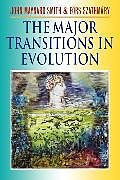The Major Transitions in Evolution
Einband:
Kartonierter Einband
EAN:
9780198502944
Untertitel:
Englisch
Autor:
Smith Julian Maynard, John Maynard Smith, Eors Szathmary
Herausgeber:
OUP Oxford
Anzahl Seiten:
362
Erscheinungsdatum:
30.10.1997
ISBN:
019850294X
During evolution there have been several major changes in the way genetic information is organized and transmitted from one generation to the next. This title discusses all the major transitions and their implications for our understanding of evolution. It is clearly written and illustrated with many original diagrams.
Autorentext
John Maynard Smith (1920-2004) was Emeritus Professor of Biology in the University of Sussex. Eors Szathmáry is at the Institute for Advanced Study, Budapest.
Klappentext
Over the history of life there have been several major changes in the way genetic information is organized and transmitted from one generation to the next. These transitions include the origin of life itself, the first eukaryotic cells, reproduction by sexual means, the appearance of
multicellular plants and animals, the emergence of cooperation and of animal societies, and the unique language ability of humans. This ambitious book provides the first unified discussion of the full range of these transitions. The authors highlight the similarities between different
transitions--between the union of replicating molecules to form chromosomes and of cells to form multicellular organisms, for example--and show how understanding one transition sheds light on others. They trace a common theme throughout the history of evolution: after a major transition some
entities lose the ability to replicate independently, becoming able to reproduce only as part of a larger whole. The authors investigate this pattern and why selection between entities at a lower level does not disrupt selection at more complex levels. Their explanation encompasses a compelling
theory of the evolution of cooperation at all levels of complexity. Engagingly written and filled with numerous illustrations, this book can be read with enjoyment by anyone with an undergraduate training in biology. It is ideal for advanced discussion groups on evolution and includes accessible
discussions of a wide range of topics, from molecular biology and linguistics to insect societies.
Zusammenfassung
During evolution, there have been several major changes in the way that genetic information is organized and transmitted from one generation to the next. These transitions include the origin of life itself, the first eukaryotic cells, reproduction by sexual means, the appearance of multicellular plants and animals, the emergence of cooperation and of animal societies, and the unique language ability of humans. This is the first book to discuss all of these major transitions. In discussing such a wide range of topics in one volume, the authors are able to highlight the similarities between different transitions - for example, between the union of replicating molecules to form chromosomes and of cells to form multicellular organisms. The authors also show how an understanding of one transition sheds light on others. A common theme in the book is that entities that could replicate independently before the transition can replicate afterwards only as part of a larger whole. Why, then, does selection between entities at the lower level not disrupt selection at the higher level? In answering this question, the authors offer an explanation for the evolution of cooperation at all levels of complexity. Written in a clear style, and illustrated with many original diagrams, this book can be read with enjoyment by anyone with an undergraduate training in the biological sciences. It will be ideal for advanced discussion groups on evolution. Although the content ranges widely from molecular biology to linguistics and from intragenomic conflict to insect societies, no detailed knowledge of any of these topics is required. Mathematical models are clearly explained, and equations and formulae are kept to a minimum.
Inhalt
List of Tables
Preface
1: Introduction
2: What is Life?
3: Chemical evolution
4: The evolution of templates
5: The chicken and egg problem
6: The origin of translation and the genetic code
7: The origin of protocells
8: The origin of eukaryotes
9: The origin of sex and the nature of species
10: Intragenomic conflict
11: Symbiosis
12: Development in simple organisms
13: Gene regulation and cell heredity
14: The development of spatial patterns
15: Development and evolution
16: The origins of societies
17: The origins of language
References
Index

Leider konnten wir für diesen Artikel keine Preise ermitteln ...
billigbuch.ch sucht jetzt für Sie die besten Angebote ...
Die aktuellen Verkaufspreise von 6 Onlineshops werden in Realtime abgefragt.
Sie können das gewünschte Produkt anschliessend direkt beim Anbieter Ihrer Wahl bestellen.
Loading...
Die aktuellen Verkaufspreise von 6 Onlineshops werden in Realtime abgefragt.
Sie können das gewünschte Produkt anschliessend direkt beim Anbieter Ihrer Wahl bestellen.
| # | Onlineshop | Preis CHF | Versand CHF | Total CHF | ||
|---|---|---|---|---|---|---|
| 1 | Seller | 0.00 | 0.00 | 0.00 |
